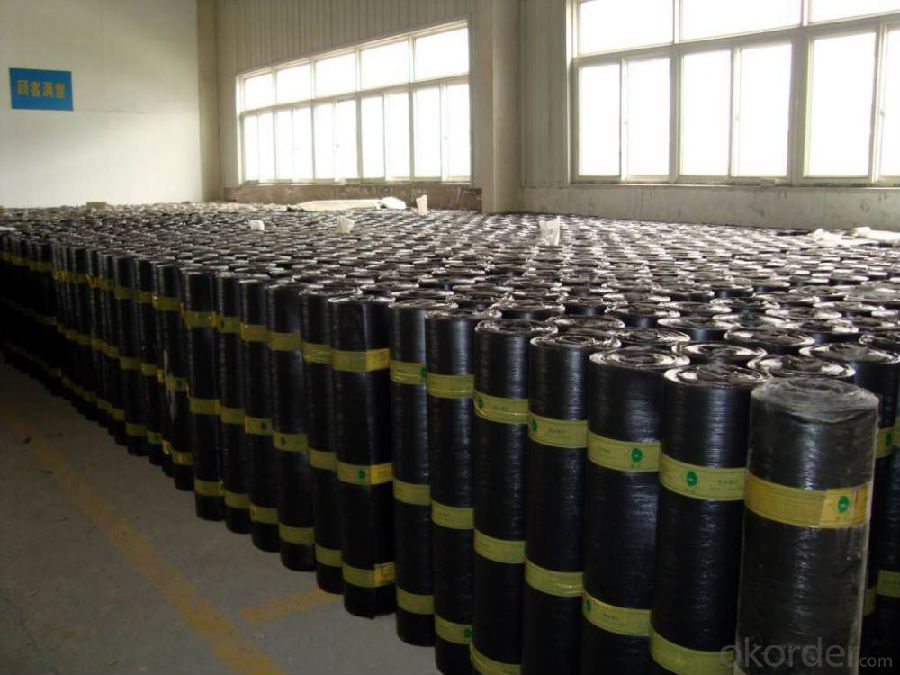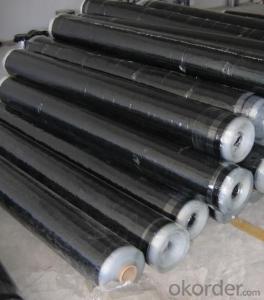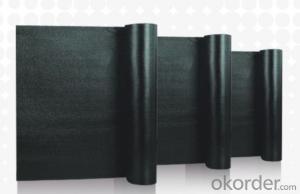Self Adhesive Modified Bituminous Waterproofing Membrane
- Loading Port:
- China main port
- Payment Terms:
- TT OR LC
- Min Order Qty:
- 5000 m²
- Supply Capability:
- 100000 m²/month
OKorder Service Pledge
OKorder Financial Service
You Might Also Like
Description
itis a modified bitumen base sheet consisting of polymer modified asphalt added viscosifier inside covering with different upper separated materials and underside with silicone antisticking layer. According to different upper surface, it includes three types: PE film surfacing (SAM-930APE), sand surfacing (SAM-930AS) and antisticking surfacing (SAM-930AN). There have two kinds of thickness: 3.0 mm and 4.0 mm.
Item | Requirement | ||
Soluble matter content, g/m 2 ≥ | 3 mm | 2100 | |
4 mm | 2900 | ||
Tensile property | Tensile strength, N/50mm ≥ | 3 mm | 600 |
4 mm | 800 | ||
Elongation at the maximum tensile force, % ≥ | 40 | ||
Resistance to heat( degree centigrade ) | 70, No sliding, flowing, dripping | ||
Flexibility at low temperature,( degree centigrade ) | -30 | ||
No cracking | |||
Water tightness | Pass at 0.3 MPa, 120 min | ||
Sheering properties N/50mm | Between membranes ≥ | 1.0 | |
Between membrane and aluminum plate ≥ | 1.5 | ||
Shank watertight | Pass | ||
Immersed in oil, pieces ≤ | 2 | ||
Holding Power/ min ≥ | 15 | ||
Thermal ageing | Elongation at the maximum tensile force, % | 40 | |
Flexibility at low temperature,( degree centigrade ) | -28 | ||
No cracking | |||
Sheering properties between membrane and aluminum plate, N/mm | 1.5 | ||
Dimension stability, % ≤ | 1.0 | ||
Self-adhesive bitumen re-peel strength, N/mm ≥ | 1.5 | ||
Surface Preparation
Surfaces should be dry, clean, smooth and free from any dusts, oil or loose particles. Cracks and uneven places need to be filled by polymer mortar.
Priming
Before membrane laying, substrate treating agent need to be brushed evenly and completely cover all laying places.
Membrane laying
After substrate treating agent drying, lay SAM-930A material according to application designs.
Sealing, fixing and constraining on vertical surfaces
On vertical surfaces, fix with metal battens and seal with sealants for membranes.
FAQ
1. Is sample available before place orders?
A: Yes, sample is ok.
2. How long is the dispatch period?
A: It will be around 20-30 days.

- Q:How does a waterproofing membrane withstand freeze-thaw cycles?
- To endure freeze-thaw cycles, a waterproofing membrane is constructed using materials that resist temperature shifts and water infiltration. Typically, these membranes consist of robust polymers like polyurethane, polyethylene, or PVC, which have low water permeability and can withstand the expansion and contraction caused by freezing and thawing. Freeze-thaw cycles allow water to seep into small cracks and pores within a structure. As the water freezes, it expands, exerting pressure on the surrounding materials. This pressure can widen cracks and weaken the structure, resulting in water leakage and potential damage. However, a waterproofing membrane acts as a barrier, preventing water from infiltrating the structure and minimizing the risk of freeze-thaw damage. The membrane is applied to the exterior surface of the structure, forming a continuous and seamless layer that prohibits water passage. It adheres securely to the surface and possesses flexibility to accommodate dimensional changes caused by temperature fluctuations. Additionally, waterproofing membranes are often reinforced with fabrics or meshes to enhance their strength and stability. These reinforcements provide further protection against damage during freeze-thaw cycles, ensuring the long-term effectiveness of the membrane. In conclusion, a waterproofing membrane endures freeze-thaw cycles by impeding water infiltration and withstanding the expansion and contraction caused by freezing and thawing. Its composition, including durable polymers and reinforcements, establishes it as a dependable barrier against water penetration, reducing the likelihood of structural damage and upholding the integrity of the protected surface.
- Q:Can a waterproofing membrane be used for HVAC systems?
- Using a waterproofing membrane directly for HVAC systems is not possible. Waterproofing membranes are designed to prevent water from penetrating surfaces like roofs, foundations, or walls. They are typically made of materials such as bitumen, rubber, or polyurethane and are intended to protect against water damage. In contrast, HVAC systems are responsible for regulating temperature, humidity, and air quality in a building. They consist of various components like ductwork, air handlers, and condensing units that are specially designed for conditioning and circulating air. While there may be some overlap in terms of protecting certain HVAC system components from moisture, such as ductwork insulation, relying solely on a waterproofing membrane is insufficient and inappropriate for HVAC systems. HVAC systems require specialized materials and equipment that are tailored to meet the specific needs and requirements of air conditioning and ventilation. Therefore, it is crucial to use the appropriate materials and equipment specifically designed for HVAC systems to ensure their efficient and effective operation.
- Q:Can waterproofing membranes be used on rooftop terraces?
- Yes, waterproofing membranes can be used on rooftop terraces to protect them from water damage and ensure their longevity.
- Q:Can a waterproofing membrane be applied to existing structures or is it only suitable for new construction?
- Yes, a waterproofing membrane can be applied to existing structures as well as new construction. Waterproofing membranes are designed to provide a protective barrier against water penetration and can be used to prevent water damage in various applications such as roofs, basements, and foundations. Whether it is an old building or a new one, applying a waterproofing membrane can help to keep the structure dry and prevent moisture-related issues such as leaks, seepage, and mold growth. However, the process of applying a waterproofing membrane to an existing structure might require additional preparation and surface treatment to ensure proper adhesion and effectiveness. It is recommended to consult with a professional waterproofing contractor who can assess the specific needs of the structure and provide appropriate solutions.
- Q:Is a waterproofing membrane resistant to cracking or shrinking?
- Yes, a waterproofing membrane is designed to be resistant to cracking and shrinking, providing a durable and long-lasting solution for preventing water penetration.
- Q:Can a waterproofing membrane be used on precast gypsum surfaces?
- Yes, a waterproofing membrane can be used on precast gypsum surfaces. This membrane acts as a barrier to prevent water penetration and can be applied to protect the gypsum surface from moisture damage.
- Q:Can a waterproofing membrane be used for roofing?
- Yes, a waterproofing membrane can be used for roofing. Waterproofing membranes are commonly used in roofing systems to prevent water infiltration and protect the structure from leaks and water damage. They provide a durable and long-lasting solution for ensuring the roof's waterproofing capabilities.
- Q:Can waterproofing membranes be used on concrete stairs?
- Concrete stairs can indeed benefit from the application of waterproofing membranes. These membranes serve the purpose of establishing a safeguarding barrier, effectively shielding the concrete from water and moisture infiltration, thus averting potential harm. By implementing a waterproofing membrane on concrete stairs, one can effectively extend their longevity, impede deterioration, and minimize the requirement for expensive repairs in the future. It is vital to select a waterproofing membrane specifically crafted for concrete usage and adhere to the manufacturer's guidelines for correct application.
- Q:Can a waterproofing membrane be used on tunnels with communication systems?
- Yes, a waterproofing membrane can be used on tunnels with communication systems. In fact, it is highly recommended to protect sensitive communication equipment and wiring from water damage. A waterproofing membrane is designed to create a barrier against water infiltration, preventing leaks and seepage. By applying a waterproofing membrane to the tunnel walls and floors, the communication systems can be safeguarded from potential water-related issues, such as corrosion, short circuits, and signal disruption. It is important to choose a waterproofing system that is compatible with the specific needs and requirements of the communication systems in the tunnel to ensure optimal protection and functionality.
- Q:Can waterproofing membranes be used on stormwater management systems?
- Yes, waterproofing membranes can be used on stormwater management systems. These membranes provide a protective barrier that prevents water from infiltrating into the system, ensuring efficient and reliable stormwater management.
1. Manufacturer Overview |
|
|---|---|
| Location | |
| Year Established | |
| Annual Output Value | |
| Main Markets | |
| Company Certifications | |
2. Manufacturer Certificates |
|
|---|---|
| a) Certification Name | |
| Range | |
| Reference | |
| Validity Period | |
3. Manufacturer Capability |
|
|---|---|
| a)Trade Capacity | |
| Nearest Port | |
| Export Percentage | |
| No.of Employees in Trade Department | |
| Language Spoken: | |
| b)Factory Information | |
| Factory Size: | |
| No. of Production Lines | |
| Contract Manufacturing | |
| Product Price Range | |
Send your message to us
Self Adhesive Modified Bituminous Waterproofing Membrane
- Loading Port:
- China main port
- Payment Terms:
- TT OR LC
- Min Order Qty:
- 5000 m²
- Supply Capability:
- 100000 m²/month
OKorder Service Pledge
OKorder Financial Service
Similar products
New products
Hot products
Hot Searches
Related keywords




























